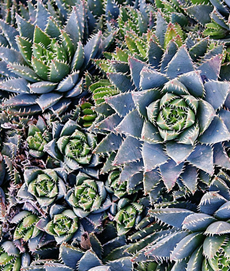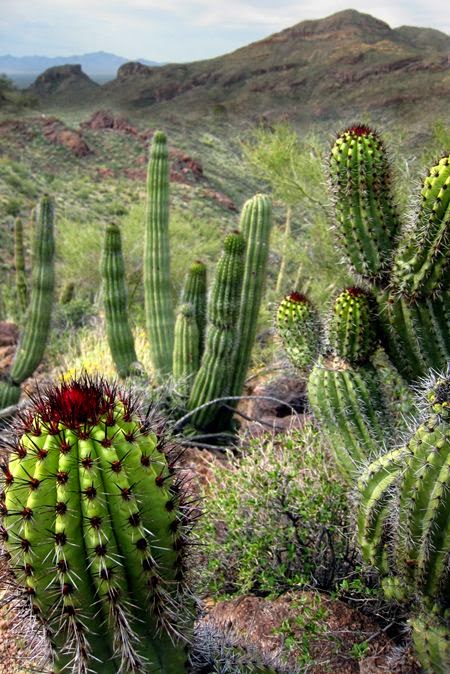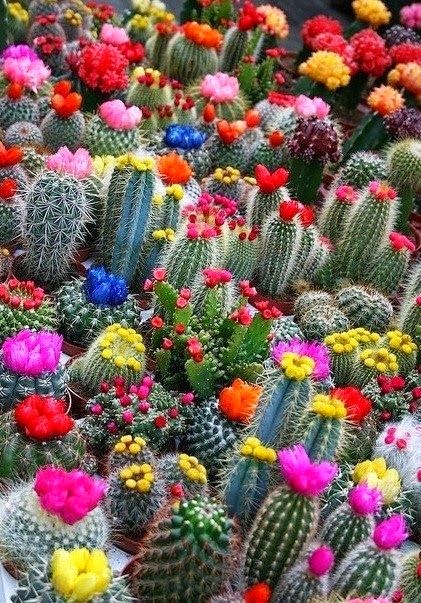Agriculture
Succulents are fleshy plants that store water in natural reservoirs such as stems or leaves. Cacti are a group of flowering plants; all cacti are succulents.
The Cactaceae family includes about 1,650 to 3,500 species of cacti and succulents classified in 130 genera. Because they live in harsh, arid environments, these fleshy, spiny perennial plants have developed a variety of unique characteristics for protection and to retain water, reduce evaporation, and resist heat.
Cacti
The word ?succulent? is derived from the Latin term sucus, meaning sap. All cacti are succulents. The word ?cactus? is derived from the Greek term kaktos, describing thistles. Botanists estimate cacti first existed during the Mesozoic era, about 130 million years ago. Limited cacti fossil evidence exists (the earliest known specimen is about forty thousand years old).
Cacti vary in size. The Copiapoa laui is a spherical plant several millimeters in diameter, while the Pachycereus weberi is cylindrical, stands more than 20 meters tall, and can weigh more than 25 tons. Cacti often develop bizarre shapes to cope with arid conditions. Some stems are flat, and others are puffy. Many consist of jointed segments, while others have one round stem.
Cacti stems swell when storing water. Surface ridges and grooves gather water. Roots extend in a wide area near the soil surface, to capture any moisture. The pincushion, barrel, saguaro, prickly pear, night-blooming cereus, and Christmas cactus are some of the most familiar cacti.
Unlike other plants, cacti have areolas on stems where branches, spines, glochids (bristles), leaves, and flowers grow. Spines protect and shade the plant and its seedlings from predators and ultraviolet radiation and serve as condensation sites. Known as crassulacean acid metabolism (CAM), photosynthesis in cacti is reversed from the process in other plants. Stems have chlorophyll because leaves are either absent or tiny.
At night, instead of day, cacti open the stomata on their stems to collect carbon dioxide and expel oxygen. The carbon dioxide is stored as organic acids for conversion to sugar during the day. Because the temperature is cooler when the stomata are opened, less water is lost. During the day, the closed stomata prevent evaporation from occurring.
Life Cycles of Cacti
Cacti grow slowly and can live more than a century. Flowers usually bloom in late spring and vary in color, size, and shape. Seeds are inside the fruits that blossoms produce. Some cacti grow from seeds if they are shaded and not consumed by predators.
Other cacti emerge from stems and take root where they fall. Artificially, cacti can also take root from cuttings. Diverse insects and animals are attracted to the flowers and assist in their pollination. Some birds nest in holes in cacti stems.
Distribution of Cacti
Cacti grow in deserts, prairies, mountains, and tropical climates and have developed a tolerance for extreme conditions. Cacti are indigenous to North, Central, and South America. The Epiphyllum species live in tropical trees. Other cacti grow in rocky places.
Some Chilean cacti in the Atacama Desert secure water from sea fog. The largest and most diverse population of cacti is in Mexico. The prickly pear is the most widely distributed cactus, ranging from near the Arctic circle to southern South America.
Uses of Cacti
 Cactus fruits are edible by humans and animals and used as livestock forage, as a water source, for fuel, and to erect organic barriers. Spines are used as needles and fishhooks, and fibers are twisted into rope. Historically, peyote is a ceremonial hallucinogenic, and other cacti have medicinal purposes. While no cacti are poisonous, some species have unpleasant chemicals that discourage predators.
Cactus fruits are edible by humans and animals and used as livestock forage, as a water source, for fuel, and to erect organic barriers. Spines are used as needles and fishhooks, and fibers are twisted into rope. Historically, peyote is a ceremonial hallucinogenic, and other cacti have medicinal purposes. While no cacti are poisonous, some species have unpleasant chemicals that discourage predators.
Some hybrids have naturally occurred, and cactus segments can be detached at joints to graft to artificially unique plants. Because of poaching, cacti are considered endangered plants, with some species threatened by extinction, and are federally protected at Saguaro National Park (in Arizona?s Tucson Basin) and Organ Pipe Cactus National Monument (in Arizona?s Sonoran Desert).
Succulents
Although they share many traits with their close relatives the cacti, other succulents do not have areolas. Succulents vary in shape and size. Some are as tiny as peas, while others are large as livestock. Succulents take many forms, including that of the string of beads (Senecio rowleyanus). Yucca and jade plants are two of the most familiar succulents.
Because of evolutionary adaptation to endure climatic extremes, succulents have small leaves and spongy tissues that keep water for prolonged durations. Succulents retain water to with stand such environmental stresses as drought, scorching wind, shallow or salty topsoil, steep locations, and over-crowding by other plants.
Succulents keep flower stalks and fruit until all the water is depleted from them. They have a thick skin, which is waxy, and sometimes alter their shape while adjusting to differences of light and moisture. Most succulents are gray, although a few are colored lilac, pink, light green, beige, or ivory, often in patterns that may serve as camouflage.
The greatest quantity and most diverse succulents can be found in Mexico and South Africa, which have thousands of species. New species are still being discovered because of variations arising from environmentally triggered adaptations. Some succulents, such as the Argyroderma, are abundant, growing in thick clumps.
The rarer succulents include Conophytum burgeri, which lives on only one South African hill. Succulents are threatened by overgrazing and industrial and agricultural development of habitats. Some succulents, particularly aloe, have healing juices to soothe burns.
- African Flora
African Flora With few exceptions, Africa?s flora (vegetation) is tropical or subtropical. This is primarily because none of the African continent extends far from the equator, and there are only a few high-elevation regions that support more temperate...
- C4 And Cam Photosynthesis
Alternative forms of photosynthesis are used by specific types of plants, called C4 and CAM plants, to alleviate problems of photorespiration and excess water loss. Photosynthesis is the physiological process whereby plants use the sun?s radiant energy...
- Deserts
DesertRegions characterized by 10 inches or less of precipitation per year as considered deserts. Plants in desert biomes are typically specialized to endure the harsh conditions found there. Deserts are regions, or biomes, too dry to support grasslands...
- Savannas And Deciduous Tropical Forests
Savannas are areas of continuous grass or sedge cover beneath trees that range from scattered, twisted, and gnarled individuals to open wood lands. Deciduous tropical forests have continuous to open forest cover and undergo a leafless period during a...
- 5 Hard-to-kill Office Plants
Everybody knows that having a plant nestled on your desk is a great way to keep healthy and productive, but nobody ever mentions the daily watering and pruning that goes with having one. When you have an urgent report to finish by five o?clock, a meeting...
Agriculture
Cacti and Succulents
 |
| Wild cacti |
Succulents are fleshy plants that store water in natural reservoirs such as stems or leaves. Cacti are a group of flowering plants; all cacti are succulents.
The Cactaceae family includes about 1,650 to 3,500 species of cacti and succulents classified in 130 genera. Because they live in harsh, arid environments, these fleshy, spiny perennial plants have developed a variety of unique characteristics for protection and to retain water, reduce evaporation, and resist heat.
Cacti
The word ?succulent? is derived from the Latin term sucus, meaning sap. All cacti are succulents. The word ?cactus? is derived from the Greek term kaktos, describing thistles. Botanists estimate cacti first existed during the Mesozoic era, about 130 million years ago. Limited cacti fossil evidence exists (the earliest known specimen is about forty thousand years old).
Cacti vary in size. The Copiapoa laui is a spherical plant several millimeters in diameter, while the Pachycereus weberi is cylindrical, stands more than 20 meters tall, and can weigh more than 25 tons. Cacti often develop bizarre shapes to cope with arid conditions. Some stems are flat, and others are puffy. Many consist of jointed segments, while others have one round stem.
 |
| Blooming cacti |
Cacti stems swell when storing water. Surface ridges and grooves gather water. Roots extend in a wide area near the soil surface, to capture any moisture. The pincushion, barrel, saguaro, prickly pear, night-blooming cereus, and Christmas cactus are some of the most familiar cacti.
Unlike other plants, cacti have areolas on stems where branches, spines, glochids (bristles), leaves, and flowers grow. Spines protect and shade the plant and its seedlings from predators and ultraviolet radiation and serve as condensation sites. Known as crassulacean acid metabolism (CAM), photosynthesis in cacti is reversed from the process in other plants. Stems have chlorophyll because leaves are either absent or tiny.
At night, instead of day, cacti open the stomata on their stems to collect carbon dioxide and expel oxygen. The carbon dioxide is stored as organic acids for conversion to sugar during the day. Because the temperature is cooler when the stomata are opened, less water is lost. During the day, the closed stomata prevent evaporation from occurring.
Life Cycles of Cacti
 |
| Pink Cactus Flower |
Cacti grow slowly and can live more than a century. Flowers usually bloom in late spring and vary in color, size, and shape. Seeds are inside the fruits that blossoms produce. Some cacti grow from seeds if they are shaded and not consumed by predators.
Other cacti emerge from stems and take root where they fall. Artificially, cacti can also take root from cuttings. Diverse insects and animals are attracted to the flowers and assist in their pollination. Some birds nest in holes in cacti stems.
Distribution of Cacti
Cacti grow in deserts, prairies, mountains, and tropical climates and have developed a tolerance for extreme conditions. Cacti are indigenous to North, Central, and South America. The Epiphyllum species live in tropical trees. Other cacti grow in rocky places.
Some Chilean cacti in the Atacama Desert secure water from sea fog. The largest and most diverse population of cacti is in Mexico. The prickly pear is the most widely distributed cactus, ranging from near the Arctic circle to southern South America.
Uses of Cacti

Some hybrids have naturally occurred, and cactus segments can be detached at joints to graft to artificially unique plants. Because of poaching, cacti are considered endangered plants, with some species threatened by extinction, and are federally protected at Saguaro National Park (in Arizona?s Tucson Basin) and Organ Pipe Cactus National Monument (in Arizona?s Sonoran Desert).
Succulents
Although they share many traits with their close relatives the cacti, other succulents do not have areolas. Succulents vary in shape and size. Some are as tiny as peas, while others are large as livestock. Succulents take many forms, including that of the string of beads (Senecio rowleyanus). Yucca and jade plants are two of the most familiar succulents.
 |
| Colorful succulents |
Because of evolutionary adaptation to endure climatic extremes, succulents have small leaves and spongy tissues that keep water for prolonged durations. Succulents retain water to with stand such environmental stresses as drought, scorching wind, shallow or salty topsoil, steep locations, and over-crowding by other plants.
Succulents keep flower stalks and fruit until all the water is depleted from them. They have a thick skin, which is waxy, and sometimes alter their shape while adjusting to differences of light and moisture. Most succulents are gray, although a few are colored lilac, pink, light green, beige, or ivory, often in patterns that may serve as camouflage.
The greatest quantity and most diverse succulents can be found in Mexico and South Africa, which have thousands of species. New species are still being discovered because of variations arising from environmentally triggered adaptations. Some succulents, such as the Argyroderma, are abundant, growing in thick clumps.
The rarer succulents include Conophytum burgeri, which lives on only one South African hill. Succulents are threatened by overgrazing and industrial and agricultural development of habitats. Some succulents, particularly aloe, have healing juices to soothe burns.
- African Flora
African Flora With few exceptions, Africa?s flora (vegetation) is tropical or subtropical. This is primarily because none of the African continent extends far from the equator, and there are only a few high-elevation regions that support more temperate...
- C4 And Cam Photosynthesis
Alternative forms of photosynthesis are used by specific types of plants, called C4 and CAM plants, to alleviate problems of photorespiration and excess water loss. Photosynthesis is the physiological process whereby plants use the sun?s radiant energy...
- Deserts
DesertRegions characterized by 10 inches or less of precipitation per year as considered deserts. Plants in desert biomes are typically specialized to endure the harsh conditions found there. Deserts are regions, or biomes, too dry to support grasslands...
- Savannas And Deciduous Tropical Forests
Savannas are areas of continuous grass or sedge cover beneath trees that range from scattered, twisted, and gnarled individuals to open wood lands. Deciduous tropical forests have continuous to open forest cover and undergo a leafless period during a...
- 5 Hard-to-kill Office Plants
Everybody knows that having a plant nestled on your desk is a great way to keep healthy and productive, but nobody ever mentions the daily watering and pruning that goes with having one. When you have an urgent report to finish by five o?clock, a meeting...
